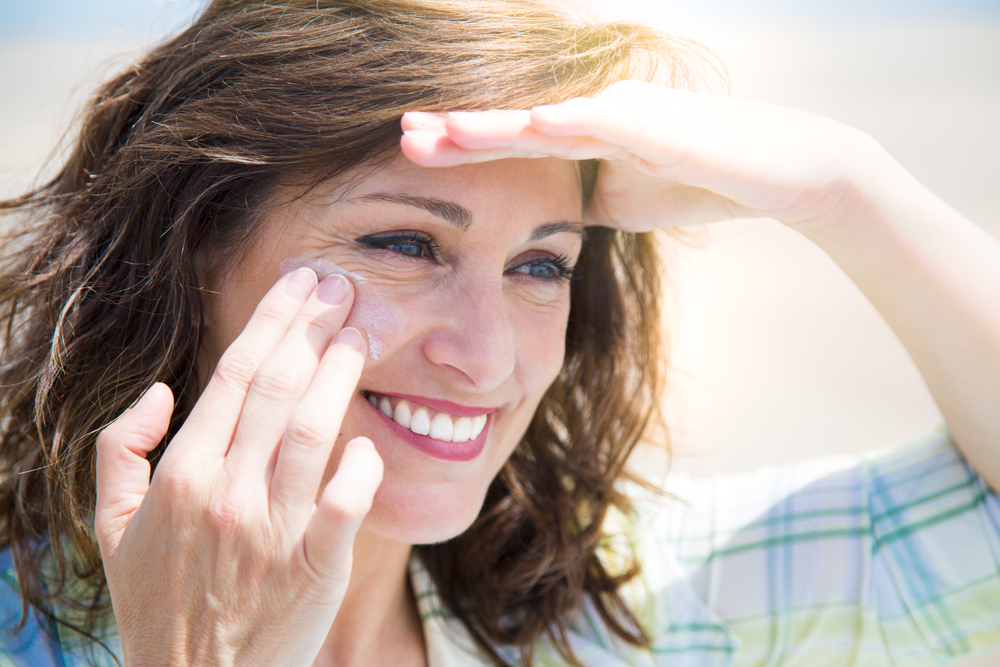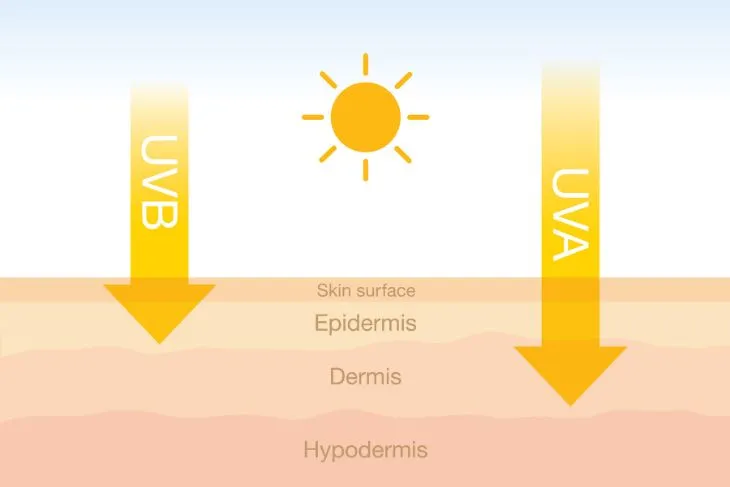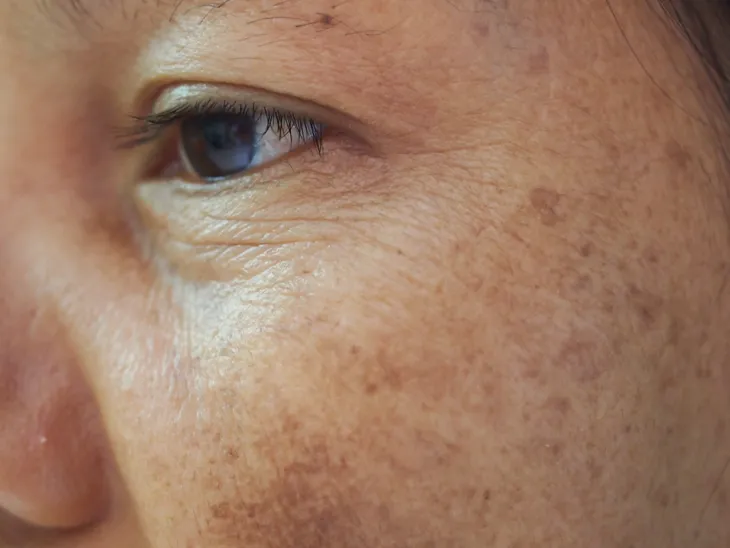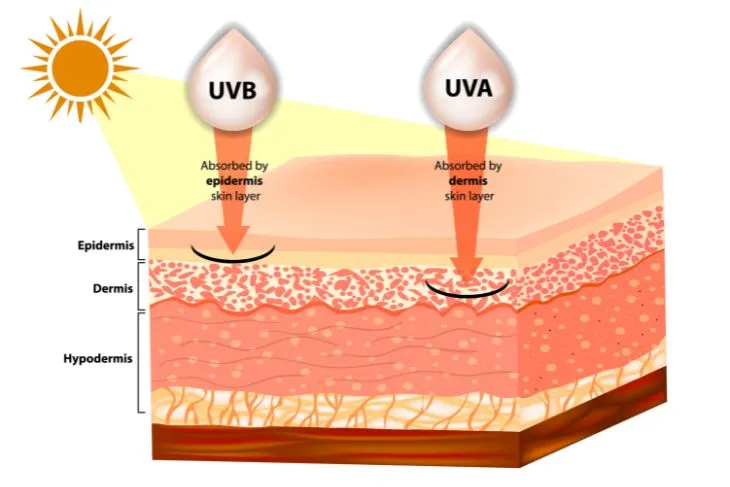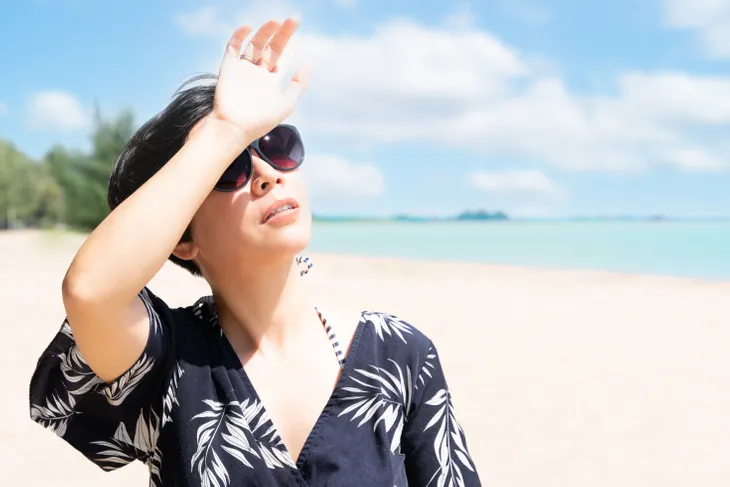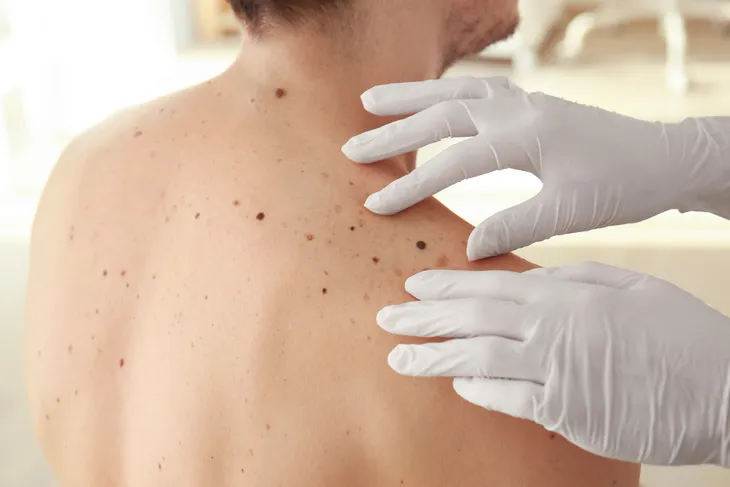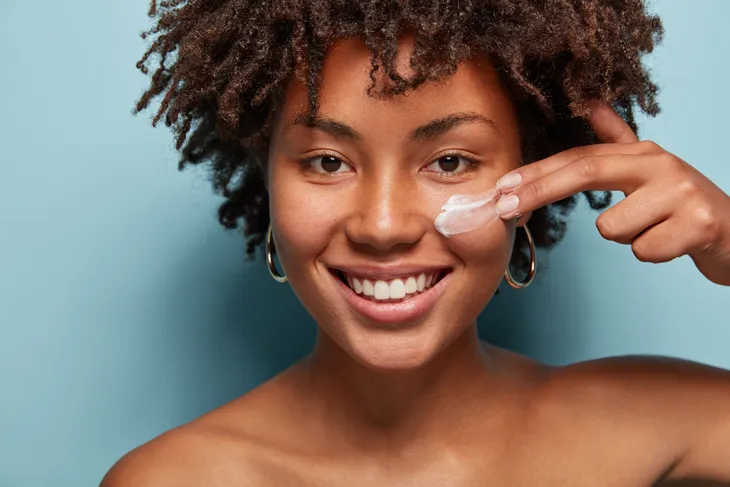- Photoaging is premature aging on the skin from the damage effects of UV rays, either from the sun or artificial tanning sources.
- The most common signs are wrinkles, pigmentation changes, loss of skin tone, uneven skin texture, broken capillaries, and redness or blotchiness.
- While the best form of treatment is prevention, there are medications (over-the-counter and prescription), as well as light-based treatment technology.
Aging is inevitable. While we might try (some more than others), we cannot avoid it. We all age and endure everything that comes with it, including the effect it can have on our skin. While wrinkles, fine lines, and pigmentation are often blamed on aging, the main culprit is photoaging — damage from exposure to sunlight and ultraviolet (UV) light, says the Skin Cancer Foundation.
Proper skin care when out in the sun is imperative to not only protect against skin cancer, but also prevent photoaging as it’s a “direct result of cumulative sun damage,” notes the source. Sun exposure occurs every day, making it a year-round concern. Here’s a closer look into photoaging, including the symptoms, causes, and treatment options…
What is Photoaging?
In the simplest sense, photoaging is premature aging on the skin. However, it’s different from chronological aging because photoaging is from the damaging effects of UV rays from either the sun or artificial tanning sources. These harmful rays have the ability to alter normal skin structures, explains the Canadian Dermatology Association.
Photoaging has many different names, according to Yale Medicine. It is sometimes referred to as photodamage, solar damage, or sun damage. It occurs when UV light hits unprotected skin and causes DNA changes at a cellular level. “Because photodamage happens in the deepest layers of the skin — the derms — it can take years before the damage surfaces and becomes visible,” writes the source.
Signs of Photoaging
Normal aging is dictated by age and genetics, but photoaging occurs when ultraviolet light from the sun or tanning beds damages the skin’s structure. To see the difference between normal chronological aging and photoaging, Yale Medicine suggests comparing areas of the body that see sunlight often to those that don’t. You’ll likely notice a difference in their appearance and texture.
Signs of photoaging will can appear as early as teenage years to early twenties. The same source lists the following as the most common symptoms:
- Wrinkling, especially around the eyes and mouth and become deep creases; forehead lines set in and are visible when not frowning
- Pigmentation changes such as age spots, liver spots (solar lentigines), uneven skin color, and freckles
- Loss of skin tone (decreased elasticity)
- Rough, uneven skin texture
- Broken capillaries (spider veins), usually around the nose, cheeks, and chest
- Redness and blotchiness
Where on the Body Does it Occur?
Since photoaging is damage done by the sun it can really only occur in places on the body that see the sun. The most common places for it to appear are those that are continuously exposed, such as the face, neck, and back of the hand. These are the areas of the body that tend to receive the most sun exposure, notes the Canadian Dermatology Association.
Another place photoaging is often seen, especially on women is the upper chest area. “The lips can also show signs of excessive sun damage,” adds the source.
What Causes Photoaging?
Photoaging is damage to the skin by UV radiation which comes from either the sun or artificial tanning sources. UV radiation is made up of UVA and UVB rays, both cause damage to the skin but UVA is responsible for aging the skin while UVB rays burn, explains VeryWell Health.
The UVA rays have longer wavelengths which is how they are able to damage the dermis of the skin. The rays target any collagen in the skin, causing them to produce more elastin. The abnormal amounts of elastin lead to the overproduction of enzymes called metalloproteinases which repair collagen. “However, these enzymes usually end up causing more harm to the collagen than good by incorrectly restoring the skin,” writes the source. “As the skin is exposed to UVA rays on a daily basis, this process keeps repeating, resulting in wrinkles and leathery skin.”
These rays are also responsible for causing fine lines, wrinkles around the eyes, mouth, and forehead, as well as age spots (sometimes called liver spots). An age spot is a spot of pigmentation from sun exposure, explains VeryWell Health. These will appear not only on the face, but anywhere on the body, including the hands, arms, chest, and back.
How Much Sun Exposure Is Too Much?
Limiting sun exposure is the key to preventing photoaging. However, certain skin types are more at risk of photoaging and will need more protection than others. A person’s skin type will determine how much sun exposure is too much. According to the Canadian Dermatology Association, fair-skinned people with blonde or red hair who burn easily are at the highest risk, as well as people who spend long periods of time outdoors.
While people with dark skin tend to show fewer signs of photoaging, the source notes their skin can become mottled and is susceptible to wrinkling. “Photoaging can begin in the teen years or early 20s,” writes the source. “Using UV light technology, areas of excess epidermal pigment (seen as freckle-like, dark spots) lying just below the skin’s surface are revealed.”
Normal Aging vs. Photoaging
We all age a little bit more each and every day. This is a normal part of life. Natural aging is a process dependent on time and genetics, says the Canadian Dermatology Association. This is unchangeable. But there are other things that are within our control when it comes to aging. Sometimes when people look older than they are, it’s a result of lifestyle choices. Things like diet, smoking, exercise, and sun exposure play a major role in how people age.
When aging appears on skin, 90-percent of it is a result of sun exposure, says the Canadian Dermatology Association. “Compare skin on an area rarely exposed to that on the face to see the difference in tone, color, and texture,” writes the source. Natural aging looks much different than aging caused by the harsh effects of the sun.
Who’s at Risk?
No one is immune to damage from the sun, but some people are more vulnerable than others. Certain skin types are more susceptible to photoaging and might need to take extra precautions. For example someone with fair skin. However, age can also play a role. VeryWell Health warns that people who are older are more at risk.
Also someone who works frequently outdoors, engages in recreational activities outdoors, or lives in a place with lots of sunshine. It’s never too early to start thinking about sun exposure and premature aging. According to Epiphany Dermatology, most of the sun damage they see in older people is cumulative damage that started in their childhood.
Know Your Skin Type
Even though we’re all susceptible to sun damage, knowing your skin type will help determine your risk level. The Fitzpatrick skin type classification is a system based on a person’s reaction to sun exposure. There are six skin type categories on the Fitzpatrick skin type scale, ranging from very fair (type 1), to very dark skin (type VI), says the Canadian Dermatology Association
- Type I: Always burns, never tans
- Type II: Usually burns, then tans
- Type III: May burn, tans well
- Type IV: Rarely burns, tans well
- Type V: Very rarely burns, tans well, brown skin
- Type VI: Very rare burns, tans well, very dark skin
What goes into determining skin type? According to the Canadian Dermatology Association there are three main factors. The first is genetic disposition. Our genetic make up plays a huge role in our appearance, including the color of our eyes and hair. The second factor is reaction to sun exposure. “The way your skin reacts to sun exposure is another important factor in correctly assessing skin type,” writes the source. The last is tanning habits which is essentially how often a person tans.
It is possible to fall into two types and have features from both. The Canadian Dermatology Association notes that skin types I and II are at the highest risk for photoaging. “In European and North American adult populations with skin types I, II, and III, the prevalence of clinically detectable photoaging may be as high as 90-percent,” adds the source.
When to See a Dermatologist
While the majority of photoaging symptoms are cosmetic in nature, when it comes to sun exposure, there’s always a risk of skin cancer. Early detection is key when treating skin cancer, so it’s best to see a dermatologist as soon as possible. This is especially true for anyone with rough, scaly spots. VeryWell Health warns this may be actinic keratoses which can be precancerous.
You should always be mindful of any signs of skin cancer. The same source advises watching for pearl-like bumps or patches on your skin, as well as any sores that don’t heal. Everyone should see a dermatologist at least once a year to check their skin. People with a heightened risk for skin cancer might need more frequent exams.
How to Treat Photoaging
If the photoaging is mild to moderate vitamin A products can be used. There are over-the-counter options as well as prescription medications, says VeryWell Health. The prescription formulas are much more concentrated and likely to be more effective. These formulas were first a treatment for acne, but are also effective at reducing wrinkles, especially fine lines and facial wrinkles.
Retinoids help treat photoaging by increasing cell turnover. This treatment requires patience as it can take a few months before there is any noticeable change. VeryWell Health adds that some people develop redness or a rash while using a high concentration product, but slowly increasing the dose over time can help combat effect.
Light-Based Treatment Technology
The first example of light-based treatment technology is photodynamic therapy. This involving applying a light sensitizing medicine to the skin. Once the medicine penetrates the skin, the light activates the medication, “promoting collagen growth that gives skin a more youthful, supple appearance,” writes VeryWell Health.
Two other forms are intense pulsed light and laser therapy. Intense pulsed light is a technique that works to reduce the appearance of uneven pigmentation and broken blood vessels. In order to see results, a patient will need multiple sessions. Laser therapy treats a variety of skin issues, it all depends on the wavelength of light. “Different wavelengths are used for minimizing blood vessels, treating age spots, reducing wrinkles, and removing hair,” says VeryWell Health.
How to Prevent Photoaging
While there are treatments available to help with the effects of photoaging, prevention works best. Obviously it’s impossible to avoid the sun entirely, but there are many things we can do to protect our skin. The easiest to do is minimize exposure. Don’t spend long hours out in the sun, if possible. Wear sun-protective clothing while outdoors and hats with wide brims.
The next thing is sunscreen, sunscreen, and more sunscreen! Always apply sunscreen, even if it’s a cloudy day. If you haven’t been good about sun protection thus far, Yale Medicine reassures it’s never too late to start. Dermatologists recommend using sunscreen that protects against both UVA and UVB rays. Make sure it has a sun protection factor (SPF) of 30 or higher and wear water-resistant formulas when necessary. Reapply sunscreen every two hours or more if swimming and exercising, notes the source.
